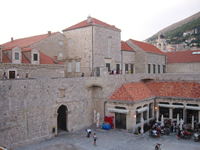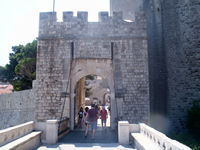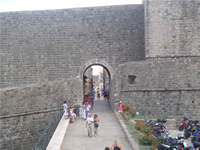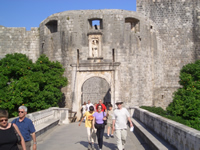| There used to be four gates leading into The City of Dubrovnik: the Pile Gate, The Ploce Gate, the Peskarija Gate and the Ponta Gate.
 
An interesting anecdote from the 15th century tells how the citizens of Dubrovnik considered opening another gate in the northern wall. However, the convened council could not agree as some claimed that opening the gate would be useful because goods could then be brought into the City more easily, while others feared it would weaken the City's defences. Hence they invited two of the best known town planners of the time, one from Ancona and the other form Genoa, to come to Dubrovnik to advise them.
To understand the story it should be noted that in the time of the Dubrovnik republic a strong rivalry existed between the towns on the Adriatic coast (Venice, Genoa, Ancona, Dubrovnik) as the towns competed for the trade supremacy in the area.
When the town planners arrived both of them advised that the gate should be opened.
The day after their departure the Rector re-convened the council and said. "It's now easy to reach a decision. Both the gentleman from Genoa and the one from Ancona think it would be most useful to us if the gate were opened. Therefore, notary write down this: "We, just in case, will not open the gate".
 However, a gate was opened in the northern part of the walls after all, but during the Austrian rule of Dubrovnik in 1908 - the so-called Buža Gate. The reason why the gate was opened was to allow Austrian army officers who were stationed in the City easy access to the tennis courts that had been made in the City wall trench. However, a gate was opened in the northern part of the walls after all, but during the Austrian rule of Dubrovnik in 1908 - the so-called Buža Gate. The reason why the gate was opened was to allow Austrian army officers who were stationed in the City easy access to the tennis courts that had been made in the City wall trench.
 Pile Gate consist of Inner and Outer City Gates. Outer City gates with a Renaissance arch in the form of a semi-circular fortress were built in 1537. To this gates, over the City trench, leads a stone bridge with a wooden drawbridge insert that was heaved up in position by means of winch and counterwights. During the Dubrovnik Republic the drawbridge was closed each night. Nowdays the gates of Dubrovnik are always open to countless visitors. Pile Gate consist of Inner and Outer City Gates. Outer City gates with a Renaissance arch in the form of a semi-circular fortress were built in 1537. To this gates, over the City trench, leads a stone bridge with a wooden drawbridge insert that was heaved up in position by means of winch and counterwights. During the Dubrovnik Republic the drawbridge was closed each night. Nowdays the gates of Dubrovnik are always open to countless visitors.
First stone bridge was build in 1397 by Ivan of Siena. That bridge had only one arch and stone benches on both sides. That bridge was the same as the outer gate bridge of Ploce Gate as the Ploce gate bridge was built in 1449-50 according to the Pile Gate prototype. Crossing this bridge one comes to the Revelin fortress.
In 1471. the City trench had been widened and the new bridge with three arches was built in lieu of the former Pile gate bridge according the design of Paskoje Miličević.
In 1533-1537 the first bridge arch had been demolished and the gate had been re-made to take on the shape as they have today and the movable wooden gate bridge had been inserted in the design.
The inner Pile gates that lead through the main City wall with a gothic arch and double door doorway were built according to the prototype of Peskarija Gate in 1460 on the place of the old City gates that are mentioned in the Statute of Dubrovnik from 1272.
 The inner Ploce Gate were once called The Gate of St Luka, according to the nearby church. Those doors are really small, their breadth is only 2m (7 ft). Thay are built in Romanesque style, with the main arch stone carved with a Romanesque head of patron of Dubrovnik, St. Blaise. Over the doors proudly stands high fortress Asimon. Next to these gates new larger gate is located. They were opened during the period of Austrian occupation in the end of 19th century. The inner Ploce Gate were once called The Gate of St Luka, according to the nearby church. Those doors are really small, their breadth is only 2m (7 ft). Thay are built in Romanesque style, with the main arch stone carved with a Romanesque head of patron of Dubrovnik, St. Blaise. Over the doors proudly stands high fortress Asimon. Next to these gates new larger gate is located. They were opened during the period of Austrian occupation in the end of 19th century.
The Outer Ploce gate are built in 1450 by Simeone della Cava, and towards the 19th century the gate were widened. As already mentioned the outer gate bridge was built according to the prototype of Pile bridge by Ivan of Siena.
|